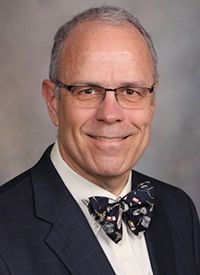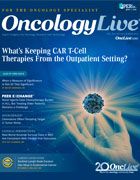Publication
Article
Oncology Live®
Novel Agents Ease Chemotherapy Burden in ALL, But Treating Older Patients Remains a Challenge
Author(s):
Immune-based approaches have revolutionized the treatment of acute lymphoblastic lymphoma, especially for patients unable to tolerate multiagent chemotherapy. Now, investigators are looking forward to seeing these agents move into frontline settings, perhaps leading to chemotherapy-free approaches.
Mark R. Litzow, MD

Mark R. Litzow, MD
Immune-based approaches have revolutionized the treatment of acute lymphoblastic lymphoma (ALL), especially for patients unable to tolerate multiagent chemotherapy. Now, investigators are looking forward to seeing these agents move into frontline settings, perhaps leading to chemotherapy-free approaches.
Those were among the observations from a panel of experts who participated in a recent OncLive Peer Exchange® discussion regarding the evolving treatment landscape for adult ALL. The panelists met during the American Society of Hematology (ASH) Annual Meeting in December 2018 and reviewed several abstracts presented at the meeting for studies of new ALL therapies. They discussed the implications of the data for practice and for future directions for ALL research.
The advancements in immune-based therapies follow the development of tyrosine kinase inhibitors (TKIs) for Philadelphia (Ph)-positive ALL, which shifted treatment paradigms for that population. Although survival rates have steadily improved for patients with ALL, the outlook for patients 60 years and older remains bleak, with only 20% surviving 5 years after diagnosis. And although only 20% of patients with ALL have the disease diagnosed after the age of 55 years, approximately half of the deaths attributed to malignancy ocurr in this population.1
New Agents for Philadelphia-Negative ALL
For these patients, “There is a need for less intensive but effective treatment strategies,” said Mark R. Litzow, MD, who served as moderator for the Peer Exchange program.The first element of risk stratification, according to Bijal D. Shah, MD, is determining whether patients are fit enough to receive intensive chemotherapy. Because age is often viewed as a barometer of fitness, fit elderly patients are frequently denied highly toxic, yet potentially curative, therapies.
Shah said that managing fit elderly patients is particularly challenging because treatment can quickly render them unfit and unable to complete therapy. “The last thing I want to do is interrupt therapy, because I think that comes with more harm than anything else,” he said. Based on data presented at the ASH meeting, Shah expressed optimism that 2 new immunotherapy agents, inotuzumab ozogamicin (Besponsa) and blinatumomab (Blincyto), might improve survival for elderly patients who have ALL.
Inotuzumab ozogamicin is an anti-CD22 monoclonal antibody conjugated to calicheamicin, a cytotoxic antibiotic. Blinatumomab is a monoclonal antibody that binds simultaneously to CD3 on T cells and CD19 on B cells; it brings the bound cells together, allowing the immune cells to eradicate the cancer cells.
Although both drugs are currently indicated only for previously treated patients with Ph-negative B-cell ALL, the panelists predicted they would eventually receive frontline indications. Anthony S. Stein, MD, speculated that if such a scenario came to pass, it could lead to chemotherapy-free regimens, “possibly within the next 5 years.”
Inotuzumab Ozogamicin
One study presented at the ASH meeting compared a regimen of inotuzumab ozogamicin plus low-intensity chemotherapy versus standard intensive chemotherapy in patients 60 years and older with newly diagnosed ALL.2 The composite rate of complete response (CR), CR with incomplete hematologic recovery (CRi), and CR with incomplete platelet recovery was 98% with the inotuzumab ozogamicin-based regimen versus 88% with high-intensity chemotherapy (P = .037).2 The inotuzumab ozogamicin arm also had significantly higher 3-year rates of event-free survival and overall survival (OS).2 Litzow called the results encouraging.
Shah agreed but expressed concern about toxicities with inotuzumab ozogamicin. He noted that inotuzumab ozogamicin can induce cytopenias and is hepatotoxic, saying the potential for veno-occlusive disease to arise long after patients discontinue inotuzumab ozogamicin presents an added wrinkle when considering transplant. “What my transplanters are telling me now is they want 4 to 6 weeks between the last dose of inotuzumab and the transplant [but] that is not always a sufficient time span in which to keep patients minimal residual disease [MRD]—negative,” he said.
Blinatumomab
Jae H. Park, MD, is an investigator for SWOG-1318, a phase II trial evaluating single-agent blinatumomab in patients older than 65 years with newly diagnosed ALL.3 Preliminary data presented at the ASH meeting showed a CR rate of 66% after 2 cycles of blinatumomab induction, which Park said compared with a historical rate of 20% with standard chemotherapy.3 “The responses are very encouraging, and toxicity also appears to be favorable,” he said.
In March 2018, the FDA granted accelerated approval to blinatumomab for patients with ALL with MRD after first or second CR. Litzow said he was surprised because the FDA previously rejected MRD as an approval endpoint. Approval was based on preliminary findings from a German study of blinatumomab in patients with MRD after CR. After 1 cycle, 78% were MRD-negative.4 “They are quite impressive data, and the drug is I think better tolerated in that setting as well,” Litzow said.
Follow-up data presented at the ASH conference showed that at a median of 53 months, median OS had not been reached in patients who were MRD-negative after blinatumomab therapy.5 Stein said when investigators stratified outcomes according to whether patients received blinatumomab at first, second, or third CR, “The best results were CR1 versus CR2 versus CR3” and that response rates and median OS progressively diminished from first to second to third CR.
CAR T-Cell Therapy
“It argues, and I think strongly, that this should be moved to the frontline,” Park said. Stein questioned whether blinatumomab might be given before chimeric antigen receptor (CAR) T-cell therapy, which he said produces better responses in patients with MRD. Shah said there is concern that blinatumomab might promote CD19 loss, compromising the efficacy of CD19-directed CAR T-cell therapy.Tisagenlecleucel (Kymriah) was the first CAR T-cell therapy approved by the FDA for B-cell ALL. It is an anti-CD19 CAR T-cell drug indicated for patients 25 years and younger who were refractory to or have relapsed after at least 2 prior therapies. Park said ongoing trials are looking at different variations of CD19-targeting CAR T-cell therapy.
Data from 2 early-phase trials of CD19 CAR T-cell therapy were presented at the ASH meeting. Both studies included patients with relapsed or refractory ALL and allowed patients with Ph-positive disease to participate.6,7 One study included patients aged 18 to 69 years; results indicated a CR/CRi rate of 72.0% and a MRD-negativity rate after treatment of 78.0%.6 The other study included patients aged 2 to 61 years and reported that, 30 days after treatment, 91.6% of patients achieved CR/CRi and 92.1% were MRD-negative.7
Park said that “70% to 80% is now the expected CR rate after CAR T-cell therapy, regardless of disease burden at the start, which is highly encouraging.” He added that most relapses occur within the first 6 to 8 months after therapy.
Tyrosine Kinase Inhibitors for Ph-Positive ALL
The most concerning toxicities of CAR T-cell therapy are cytokine release syndrome and neurotoxicity, which Park said occur primarily in adults. “I believe that this type of immunotherapy will work better in earlier lines,” he said. Ongoing trials are also looking at anti-CD22 CAR T-cell therapies, which Stein said might be more amenable for use after blinatumomab therapy.Litzow said TKIs—imatinib (Gleevec), dasatinib (Sprycel), nilotinib (Tasigna), bosutinib (Bosulif), and ponatinib (Iclusig)—have revolutionized the treatment of Ph-positive ALL “and are turning that from a very poor prognosis subset of ALL into a good prognosis.” The panelists discussed the need for more direction on how to sequence the TKIs and how long to continue TKI therapy.
They also considered whether blinatumomab might have a role for patients who are Ph-positive. “I think we’re ready…at least during the consolidation regimen and maybe perhaps at induction, too,” Park said.
Data were presented at the ASH meeting from a retrospective study of 15 patients with Ph-positive ALL who received blinatumomab plus ponatinib after relapse.8 Overall, 93% of patients (14/15) achieved cytologic CR, and 86% of those patients (12/14) had a complete molecular response. However, 47% of patients discontinued blinatumomab after the first cycle due to neurologic events or infection.8
Litzow said his group is planning a trial that would randomly assign younger patients to either dasatinib or ponatinib combined with either chemotherapy or blinatumomab. “That will be a fantastic trial,” Shah said.
References
- Aldoss I, Forman SJ, Pullarkat V. Acute lymphoblastic leukemia in the older adult. J Oncol Pract. 2019;15(2):67-75. doi: 10.1200/JOP.18.00271.
- Sasaki K, Kantarjian HM, Short NJ, et al. Inotuzumab ozogamicin in combination with low-intensity chemotherapy (mini-hyper-CVD) vs. standard intensive chemotherapy (hyper-CVAD) as frontline therapy for older patients with Philadelphia chromosome-negative acute lymphoblastic leukemia (ALL): a propensity score analysis. Blood. 2018;132(suppl 1):34. ash.confex.com/ash/2018/webprogram/ Paper115271.html.
- Advani AS, Moseley A, O’Dwyer KM, et al. Results of SWOG 1318: a phase 2 trial of blinatumomab followed by POMP (prednisone, vincristine, methotrexate, 6-mercaptopurine) maintenance in elderly patients with newly diagnosed Philadelphia chromosome negative B-cell acute lymphoblastic leukemia. Blood. 2018;132(suppl 1):33. ash.confex.com/ash/2018/webprogram/Paper111992.html.
- Gökbuget N, Dombret H, Bonifacio M, et al. Blinatumomab for minimal residual disease in adults with B-cell precursor acute lymphoblastic leukemia. Blood. 2018;131(14):1522-1531. doi: 10.1182/blood-2017-08-798322.
- Goekbuget N, Dombret H, Zugmaier G, et al. Blinatumomab for minimal residual disease (MRD) in adults with B-cell precursor acute lymphoblastic leukemia (BCP-ALL): median overall survival (OS) is not reached in complete MRD responders at a median follow-up of 53.1 months. Blood. 2018;132(suppl 1):554. ash.confex.com/ash/2018/webprogram/Paper111516.html.
- Wierda WG, Bishop MR, Oluwole OO, et al. Updated phase 1 results of Zuma-3: Kte-C19, an anti-CD19 chimeric antigen receptor T cell therapy, in adult patients with relapsed/refractory acute lymphoblastic leukemia. Blood. 2018;132(suppl 1):897. ash.confex.com/ash/2018/webprogram/Paper111531.html.
- Zhang X, Lu X-a, Yang J, et al. Efficacy and safety of CD19 chimeric antigen receptor (CAR) T cell therapy for B-cell acute lymphocytic leukemia (B-cell ALL) in a large cohort including patients with extramedullary disease (EMD), high leukemia burden, BCR-ABL (+) mutation, TP53 mutation, and post-transplant relapse. Blood. 2018;132(suppl 1):280. ash.confex.com/ash/2018/webprogram/Paper115642.html.
- Couturier M-A, Thomas X, Huguet F, et al. Blinatumomab + ponatinib for relapsed Ph1-positive acute lymphoblastic leukemia: the French experience. Blood. 2018;132(suppl 1):4014. ash.confex.com/ash/2018/webprogram/ Paper111546.html.























%20(2)%201-Recovered-Recovered-Recovered-Recovered-Recovered-Recovered-Recovered-Recovered-Recovered-Recovered-Recovered-Recovered-Recovered-Recovered-Recovered-Recovered-Recovered.jpg?fit=crop&auto=format)
%20(2)%201-Recovered-Recovered-Recovered-Recovered-Recovered-Recovered-Recovered-Recovered-Recovered-Recovered-Recovered-Recovered-Recovered-Recovered-Recovered-Recovered-Recovered.jpg?fit=crop&auto=format)
